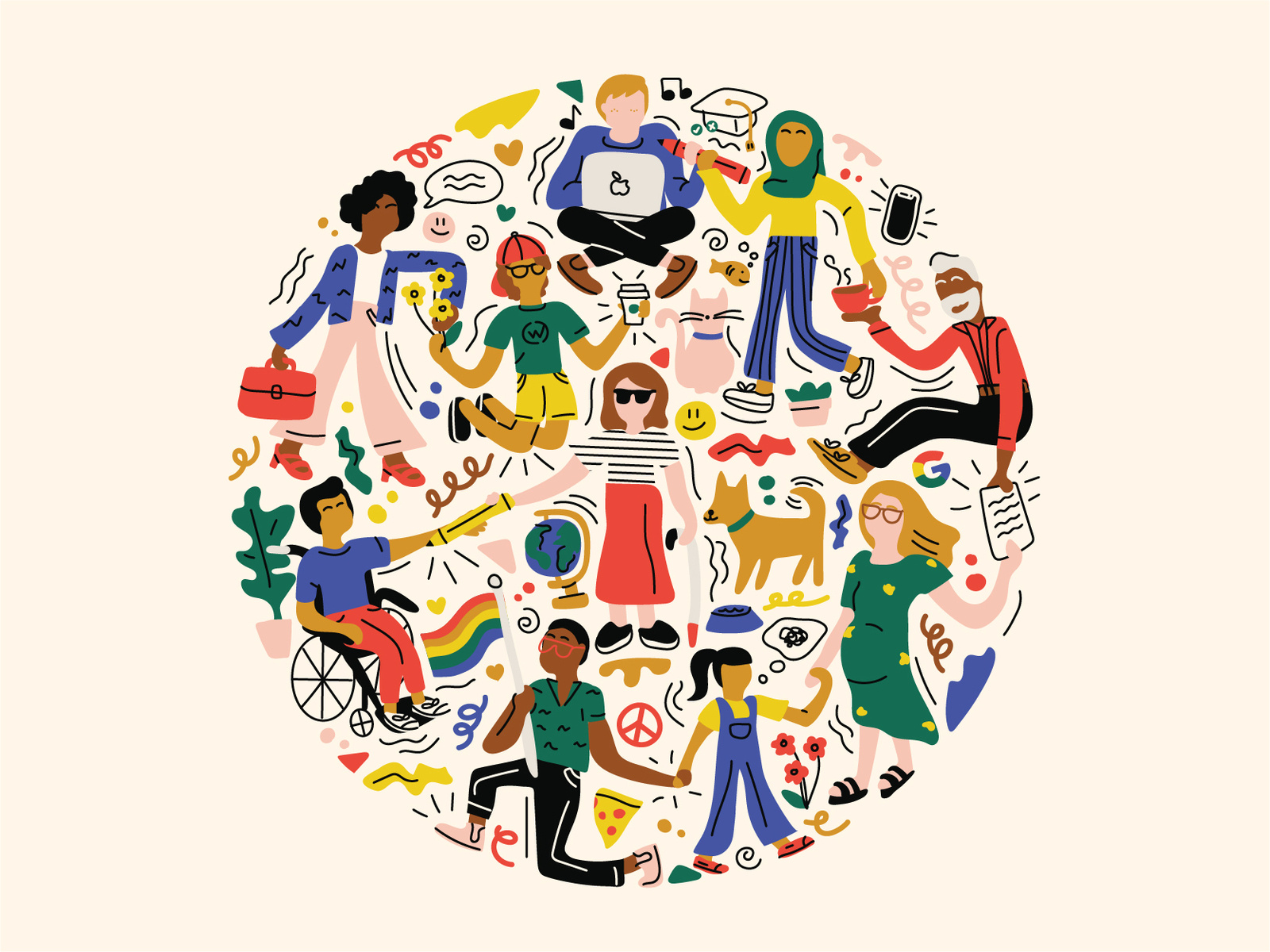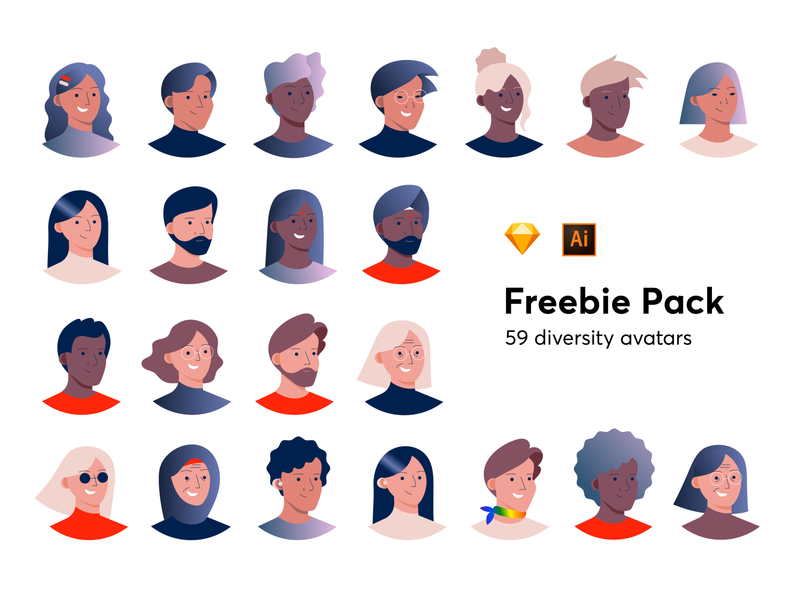In 1999, the first Web Content Accessibility Guidelines were released to the public. They ushered in an era of making the web accessible for people with disabilities.
While accessibility is a key component of inclusive design, it’s only one part of the picture. Inclusive design goes a step further to create a positive user experience for all people on the web.
In this article, we’ll explore 6 ways you can start designing more inclusive digital products that take into account the full spectrum of human diversity.
“To effectively design for modern, multicultural audiences, we have to be willing to challenge our usual ways of gathering inspiration & conceptualizing our projects.” — Senongo Apkem, Author of Cross-Cultural Design
- Remember there is no “normal” user
- Identify your assumptions
- Present information in multiple ways
- Be wary of using color to convey information
- Embrace bigger typography
- Test with diverse users

What is inclusive design?
First things first: What does inclusive design mean exactly? Unlike accessibilty, inclusive design doesn’t only account for disabilities that might affect web content access. It also considers environmental, cultural, and other aspects of human existence in creating a web that is usable by all.
Inclusive design aims to include as many people as possible in a product or experience. It’s a design method that strives to create products and experiences that take into account all forms of human diversity. This usually involves considering many different identity-based factors that include:
- Language
- Gender
- Age
- Culture
- Ethnicity
- Ability
Now, let’s dig into some concrete ways you, as a designer, can start thinking and designing more inclusive experiences on the web.

Remember there is no “normal” user
One of the key tenets of inclusive design is that there is no “normal” web user. What many designers consider to be a typical user doesn’t universally exist. Even your “average” user may have temporary circumstances that prevent easy use of standard website features.
Consider audio content for example. While someone with a hearing impairment may have issues accessing audio content, someone who’s sitting in a loud restaurant may also not be able to access that content. The situation is temporary in the second case, but the solution to both issues (creating a transcript of the audio content) creates a more usable website for all.
The same goes for someone who may only be able to interact with a UI with one hand. This could apply to someone with a permanent physical disability, someone who’s broken an arm, or even a new parent who may often be carrying their child with one arm. Making a mobile UI that can be interacted with single-handedly creates a more usable app or website for all of those users.
It’s key when creating inclusive designs to consider all of the possible use cases that users may present, whether those are permanent or temporary, environmental or cultural, etc.

Identify your assumptions
The biggest oversights designers can make in creating inclusive designs comes from their own assumptions. We can easily overlook alternative use cases when we, ourselves, have not experienced those situations.
Before you embark on any design project, consider the assumptions you’ve made about the product’s users. Then think about who else might be using the same product and in what situations.
For example, let’s say you’re developing a mobile game. Audio content can add to a rich gaming experience, but there should always be alternatives for gaining necessary information that doesn’t require listening. Besides a hearing impairment, someone might be playing with their volume down to prevent disturbing others or might be in the aforementioned loud environment where they can’t hear.
If you’re having a hard time identifying your assumptions, consult focus groups or colleagues. Ask a diverse group of people how they use particular types of digital products to get an idea of use cases you might not have considered.

Present information in multiple ways
Presenting information on a website in multiple ways makes that information easier to access for everyone. Closed captions on videos, transcripts for podcasts, and visual representations of text content can all make information more accessible to all.
One big advantage to presenting information in multiple ways is that it helps account for various learning styles. Some people learn best by seeing something demonstrated. Others may learn better by reading the information. Still, others might prefer to listen to a concept being explained.
When you can provide content in as many formats as possible, you make it possible for people to consume that content in whatever way works best for them.
Be wary of using color to convey information
Color can be a powerful tool for evoking emotions, influencing behavior, and conveying information. But there are a couple of issues with relying solely on color for any of these things.
First, colorblind users may not be able to effectively discern information that’s solely represented with color (such as sections of a pie chart). There are tools you can use to minimize this, but it’s a good idea to also present the information in alternate ways.
Second, there are cultural differences that influence how various colors are perceived in different cultures. For example, in much of the western world white is associated with purity, cleanliness, and innocence. But in much of Asia, it’s associated with death.
When designing for a global user base, it’s important to understand the implications of color across cultures.

Embrace bigger typography
Bigger typography has been a prominent web design trend for a few years. What’s often overlooked, though, is the impact it has on inclusivity.
Larger typography makes content easier to read for everyone, whether they have a vision impairment or not. It can reduce eye strain, make it easier to read content on smaller screens, and generally just make websites more usable.
Test with diverse users
The key to creating truly inclusive designs is to test those designs with diverse users. Don’t rely on user testing from people whose life experiences and situations are nearly identical to your own. Seek out those with diverse experiences, backgrounds, and abilities to see where the shortfalls are in your products.
This kind of user testing should be done throughout the design process. When you design with exclusivity in mind from the beginning, your finished product will better serve the needs of all of your potential users. ■
MORE INCLUSIVE DESIGN RESOURCES
- Cross-Cultural Design: 4 ways to get started
- Redesigning cliches: How to choose stock imagery for the 21st century
- 8 mobile UX best practices every designer should consider
![]() About the Author — Cameron Chapman: Editor. Blogger. Author. Designer. Copywriter. Marketer. Entrepreneur. Speaker. Consultant. Coach. I wear a lot of hats. What most of them have in common, though, is storytelling.
About the Author — Cameron Chapman: Editor. Blogger. Author. Designer. Copywriter. Marketer. Entrepreneur. Speaker. Consultant. Coach. I wear a lot of hats. What most of them have in common, though, is storytelling.
Find more Community stories on our blog Courtside. Have a suggestion? Contact stories@dribbble.com.












